The Best Wines for Weight Loss: Sip and Stay Slim
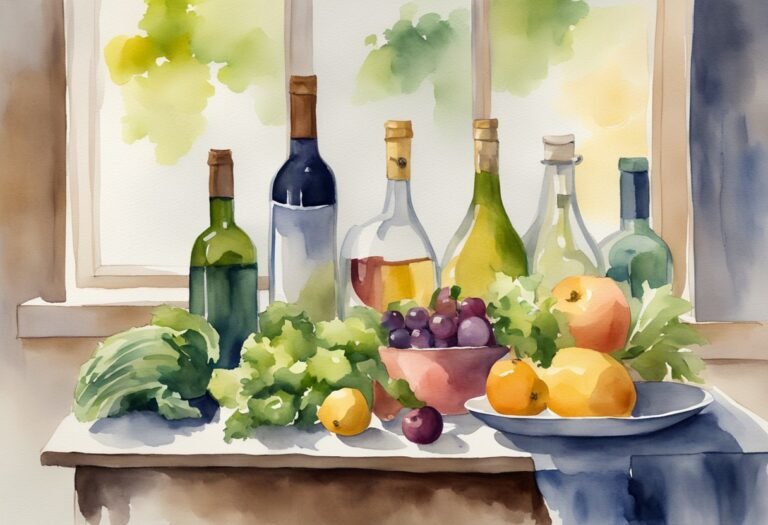
Trying to find ways to enjoy wine while still aiming for weight loss? You’re not alone.
Many people love the occasional glass of wine but worry about its impact on their health goals. The good news is certain wines can fit into a weight loss plan when enjoyed in moderation.
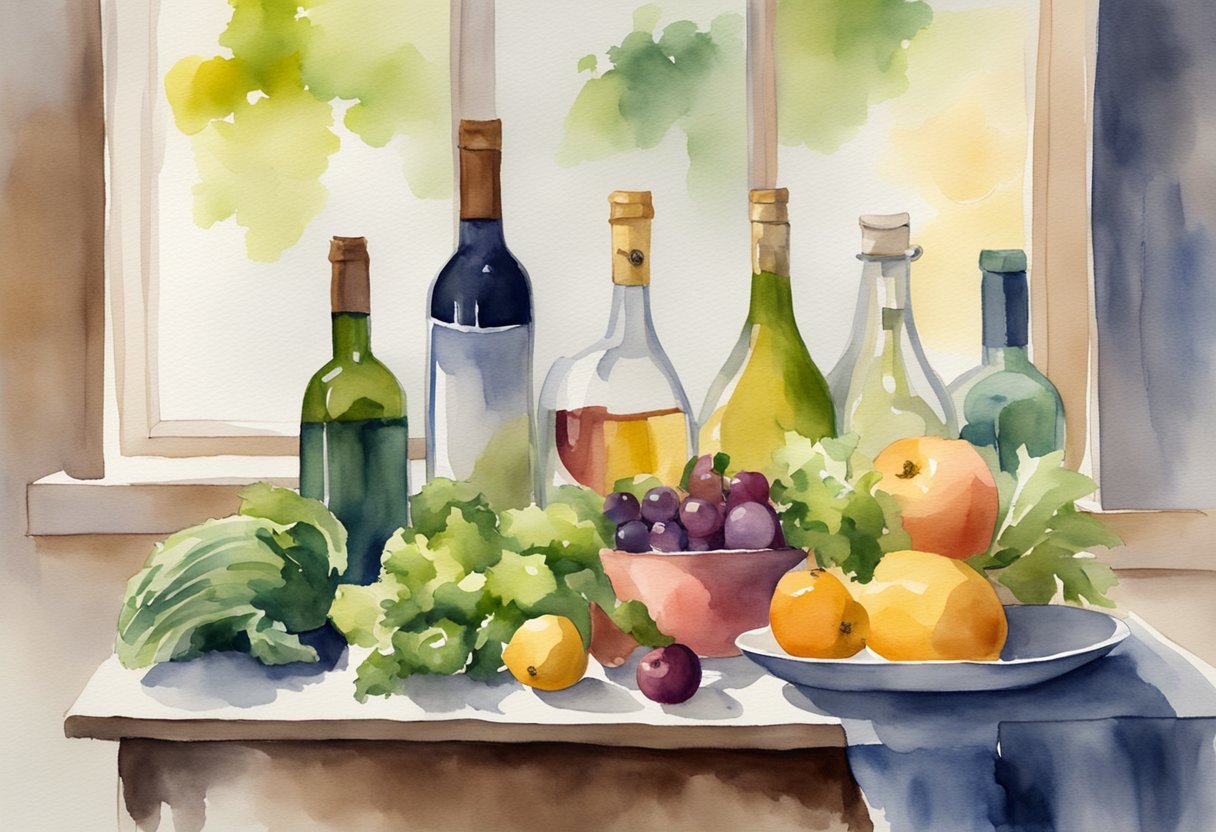
When looking at the best wines for weight loss, white wines like chardonnay, white zinfandel, and sauvignon blanc often come up as good choices.
They typically have lower calories and carbs, making them easier to fit into a calorie-controlled diet.
Some brands like Cupcake Vineyards’ Sauvignon Blanc or 2018 Finke’s Barrel-Aged Sparkling Chardonnay offer delicious options that won’t derail your progress.
Remember, the key is moderation and making mindful choices.
Key Takeaways
- Certain wines have lower calories and carbs.
- Enjoy wine in moderation to support weight loss.
- Choose wines and brands that fit your health goals.
Understanding Wine and Weight Loss
When you’re trying to lose weight, choosing the right wine can make a big difference.
It’s all about selecting wines with lower calories, carbs, and sugar content.
Alcohol and Metabolism
Alcohol can impact your metabolism.
When you drink alcoholic beverages, your body prioritizes metabolizing the alcohol first.
This means other calories in your drink or food get stored as fat.
Wine’s alcohol by volume (ABV) is a key factor.
Higher ABV wines, like reds, usually contain more calories.
For weight loss, opt for wines with lower ABV, around 9-12%.
These won’t disrupt your metabolism as much as higher ABV choices.
The Impact of Carbs and Sugars
Carbs and sugars in wine add extra calories.
Wines like Pinot Grigio, Sauvignon Blanc, and Merlot are dry with fewer carbs.
Dry wine typically has fewer than 4 grams of carbs per serving, while sweeter wines can have more than 8 grams.
Checking the sugar content is crucial, as some wines are high in residual sugar, contributing to higher calorie counts.
Best Picks:
- White Zinfandel: Low in carbs and calories.
- Sauvignon Blanc: Light and low in sugars.
- Dry Sparkling Wines: Lower in carbs and sugar content.
Choosing the Right Wines for Your Health Goals
Picking the right wine can make a difference in your health journey.
It’s important to know which types of wine are better for weight loss and overall wellness.
White Wine vs. Red Wine
When considering white wines, Sauvignon Blanc and Chardonnay are lower in calories, often under 85 calories per serving.
These options help you stick to a low-carb diet while enjoying your drink.
On the other hand, red wines like Pinot Noir or Merlot contain beneficial antioxidants such as resveratrol.
These compounds can support heart health. Cupcake LightHearted Pinot Noir is a popular low-calorie choice, with only 80 calories per serving.
Low-sugar wines are also crucial.
Wines labeled as “dry” typically have less sugar.
Look for Brut or Extra Brut on labels to minimize sugar intake while sipping your favorite wine.
Health Benefits of Moderate Wine Drinking
Drinking wine in moderation can offer surprising health perks.
Two key areas where wine shines are in its benefits for heart health and its powerful antioxidants.
Wine and Cardiovascular Health
Moderate wine drinking, especially red wine, has been linked to better heart health.
This is mainly due to compounds called polyphenols.
One well-known polyphenol is resveratrol.
Resveratrol can help protect the lining of your blood vessels.
This may reduce bad cholesterol (LDL) and prevent blood clots.
Some studies suggest that a small amount of wine can even raise good cholesterol (HDL).
Overall, having the occasional glass of wine might support your heart and blood circulation.
Just remember to drink it in small amounts—usually, this means no more than one glass per day for women and two for men.
Wine’s Antioxidant Properties
Besides resveratrol, wine is rich in other antioxidants.
Antioxidants help fight off free radicals, which are harmful molecules that can damage your cells.
Red wine, more so than white, includes lots of these beneficial compounds.
The antioxidants in red wine come from the grape skins and seeds, which are used during production.
These antioxidants can help reduce inflammation and oxidative stress in your body.
This may assist in lowering risks of chronic diseases and aging-related issues.
So, sipping wine might give your body a beneficial boost, thanks to these antioxidant properties.
Just keep it moderate for the best health benefits.
Top Varietals for Weight Loss
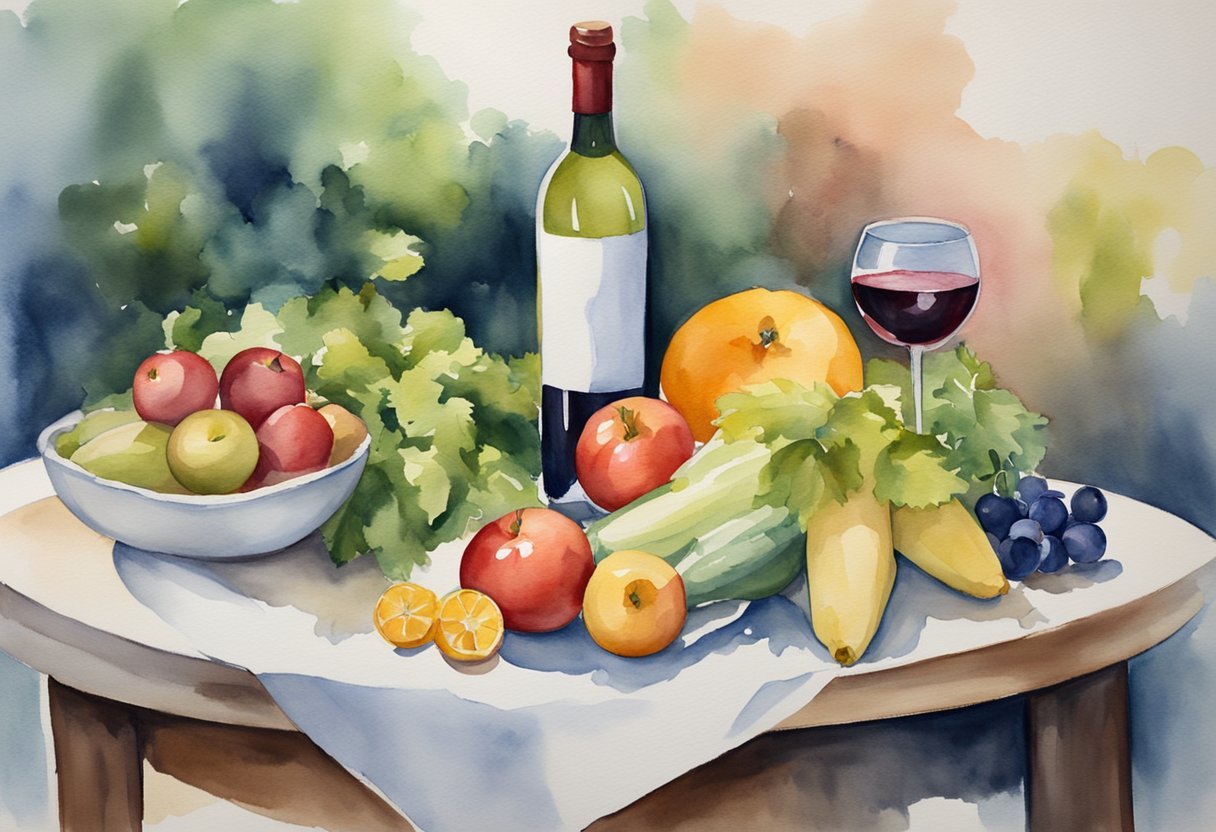
When choosing wine while watching your weight, it’s best to go for types that are lower in calories and sugar.
Here are some great options that fit the bill.
Light to Medium-Bodied Reds
Pinot Noir is a fantastic choice if you like red wines but want to keep it light.
With fewer calories and a lower alcohol content compared to heavier reds, it’s also rich in antioxidants. Merlot is another good pick.
It has a bit more body but still won’t pack on the calories.
Cabernet Sauvignon is heavier but can still fit into your diet when consumed in moderation.
These reds offer robust flavors without adding too many extra calories.
Dry White Wines
For white wine lovers, dry options like Sauvignon Blanc and Chardonnay are excellent choices.
Pinot Grigio is also a solid option for its light and refreshing character.
These wines typically have fewer calories and less sugar than sweeter white wines.
Sauvignon Blanc and Chardonnay are known for their crisp and clean flavors, making them a delightful, diet-friendly pick.
By focusing on dry and light styles, you can enjoy your wine without worrying too much about your calorie intake.
Exploring Low-Carb and Low-Sugar Wines
When choosing wines for weight loss, understanding the differences between dry and sweet varietals and knowing which labels to look for can make a big difference.
Focus on wines with lower residual sugars and alcohol by volume (ABV).
Dry Vs. Sweet Varietals
Dry wines usually contain fewer carbs and sugars compared to sweet wines. Dry whites like Chardonnay, Pinot Grigio, and Sauvignon Blanc have about 3 grams of carbs per serving.
They’re crisp, refreshing, and pair well with a variety of foods.
Sweet wines such as Riesling and Chenin Blanc tend to have higher sugar content.
Though delicious, they can derail your weight loss goals if not consumed in moderation.
You might also consider extra brut champagne which is very dry and low in sugar.
Labels to Look For
When shopping for low-carb and low-sugar wines, always check the label for alcohol by volume (ABV) and residual sugars.
Aim for wines with 13% ABV or less.
Look for the terms “dry” or “extra brut” to find wines with lower sugar content.
Low-carb wine options include reds like Cabernet Sauvignon and Chianti, which usually have around 3-4 grams of carbs per serving.
Whites like Sauvignon Blanc and Chardonnay are also great choices.
Low-calorie wines often list their calorie and sugar content, making it easier for you to choose wisely.
Spotlight on Brand Choices

Choosing the best wine for weight loss often means looking for low-calorie, organic, or biodynamic options.
Different brands cater to these needs by providing lighter yet flavorful choices.
Popular Low-Calorie Brands
When searching for low-calorie wines, you have plenty of options. FitVine is a fantastic brand, offering wines that are both low in calories and carbs.
Their wines are made with fewer additives, making them a good choice if you are mindful of ingredients.
Skinnygirl is another popular brand.
They focus on creating wines that are lower in calories while still tasting great.
With Skinnygirl, you can enjoy a glass of wine without the guilt.
Cupcake LightHearted offers a variety of low-calorie wines under 80 calories per serving.
They have whites like Sauvignon Blanc and light reds, making them perfect for any occasion.
| Brand | Calories per Serving | Main Feature |
|---|---|---|
| FitVine | ~90-95 | Low in additives |
| Skinnygirl | ~85-100 | Focus on flavor and fewer calories |
| Cupcake LightHearted | ~80 | Low-calorie whites and reds |
Organic and Biodynamic Options
If you prefer organic wines, Avaline is an excellent choice.
Avaline wines are made from organic grapes and have no added sugars.
They are clean, simple, and ideal for health-conscious wine lovers.
Another brand worth noting is Bonterra.
They provide a range of organic wines crafted with sustainable farming practices.
This means the wines are not only better for your health but also kinder to the environment.
Frey Vineyards offers biodynamic wines that incorporate holistic farming practices.
Frey Wines are free from sulfites and made with biodynamic grapes, ensuring you get the purest wine possible.
| Brand | Special Feature | Type |
|---|---|---|
| Avaline | Organic, no added sugar | Whites, Reds, Rosé |
| Bonterra | Organic, sustainable farming | Various varietals |
| Frey Vineyards | Biodynamic, sulfite-free | Various varietals |
By considering these brand choices, you can enjoy your wine while keeping your weight loss goals in check.
The Truth About Wine Additives
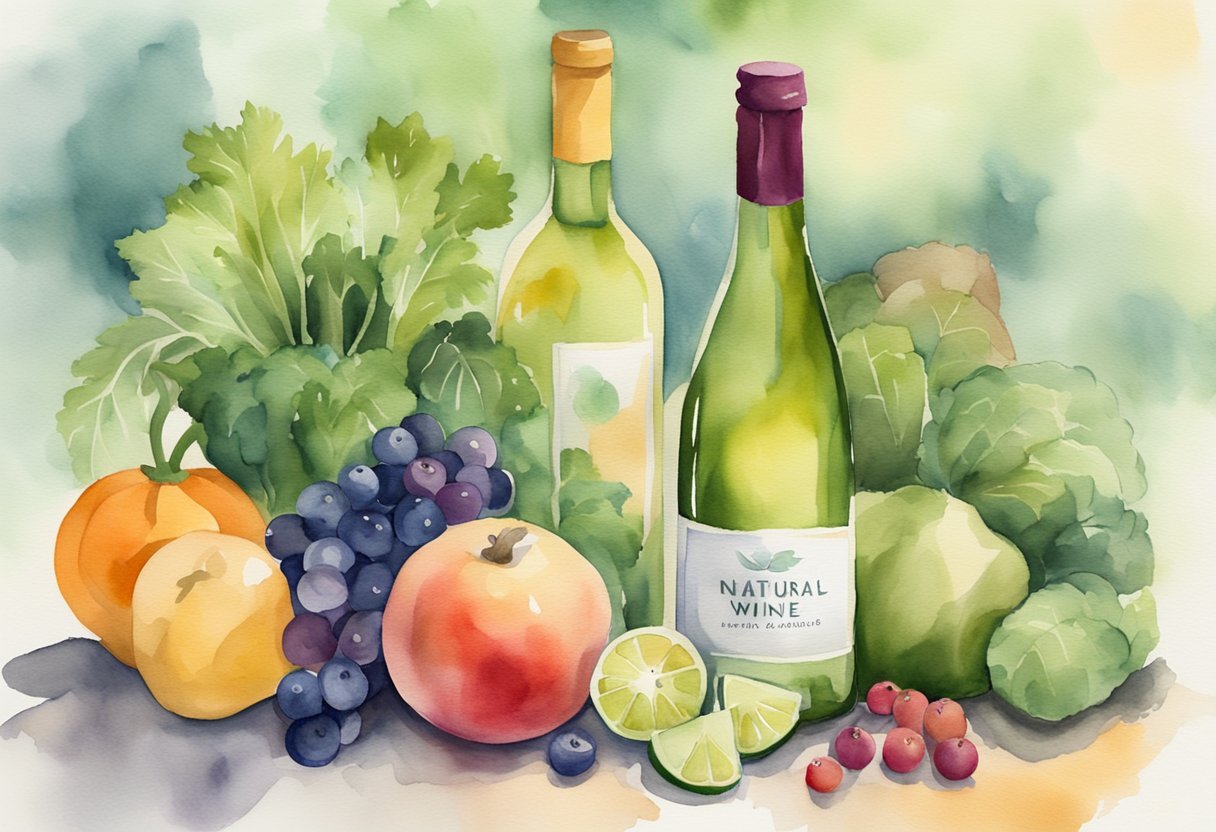
When selecting wine for weight loss, it’s essential to understand the role of additives.
Additives can affect the quality, taste, and health impact of your wine.
Sulfites and Wine
Sulfites are used as preservatives in wine to keep it fresh and prevent spoilage.
You’ll find them in both red and white wines.
Some people may be sensitive to sulfites, which can cause headaches and other symptoms.
Wine undergoes a fermentation process where sugars are converted into alcohol.
During this process, natural sulfites are produced.
However, winemakers often add extra sulfites to ensure longevity and stability, especially in mass-produced wines.
If you’re worried about sulfites, you can look for wines labeled “sulfite-free” or “low sulfite.” These wines usually contain fewer added chemicals but may have a shorter shelf life.
Natural vs. Synthetic Additives
Wine can contain various additives beyond sulfites. Natural additives include tannins, which give wine its dry taste and help with aging.
These are key in wines like Cabernet Sauvignon and Merlot.
Natural wines use fewer synthetic additives.
Winemakers of natural wine rely on organic grapes and natural fermentation.
They might add items like oak chips for flavor or egg whites to clarify the wine.
Synthetic additives are generally used in mass-produced wines.
These can include artificial flavoring, coloring, and stabilizers like potassium sorbate.
While they can improve taste and appearance, they may also introduce unwanted chemicals into your wine.
Choosing wines with natural additives can offer a more authentic taste and fewer chemicals, helping you stay closer to your weight loss goals.
Pairing Wine with a Diet-Friendly Meal
Enjoying a great glass of wine while sticking to a healthy meal plan is possible.
Pairing the right wine with nutritious foods can enhance flavors without undoing your hard work.
Wine Pairing Basics
When choosing a wine to go with your healthy meals, think about the weight of both the wine and the food. Lighter wines, like Sauvignon Blanc, pair well with salads or fish.
Meanwhile, heavier wines, like a full-bodied red, can match with lean meats.
Moderation is also key.
A glass of wine is about 5 ounces, and even a healthier option like a low-calorie wine should be enjoyed in moderation to keep calories in check.
Look for wines with lower alcohol content, as these often have fewer calories.
Recipes for a Healthy Balance
Consider pairing a grilled chicken salad with a light Chardonnay.
The wine’s crispness complements the salad’s fresh ingredients.
For a more indulgent meal, try baked salmon with a side of steamed vegetables.
Pair this with a glass of Riesling, which has a touch of sweetness to balance the savory fish.
Here’s a quick recipe idea:
Grilled Veggie Plate:
- Zucchini slices
- Bell peppers
- Red onions
- Olive oil spray
- Salt and pepper to taste
Grill the veggies until slightly charred.
Pair this dish with a glass of Pinot Grigio.
The wine’s zesty notes will highlight the vegetables’ natural flavors without overwhelming them.
Considerations Beyond the Glass
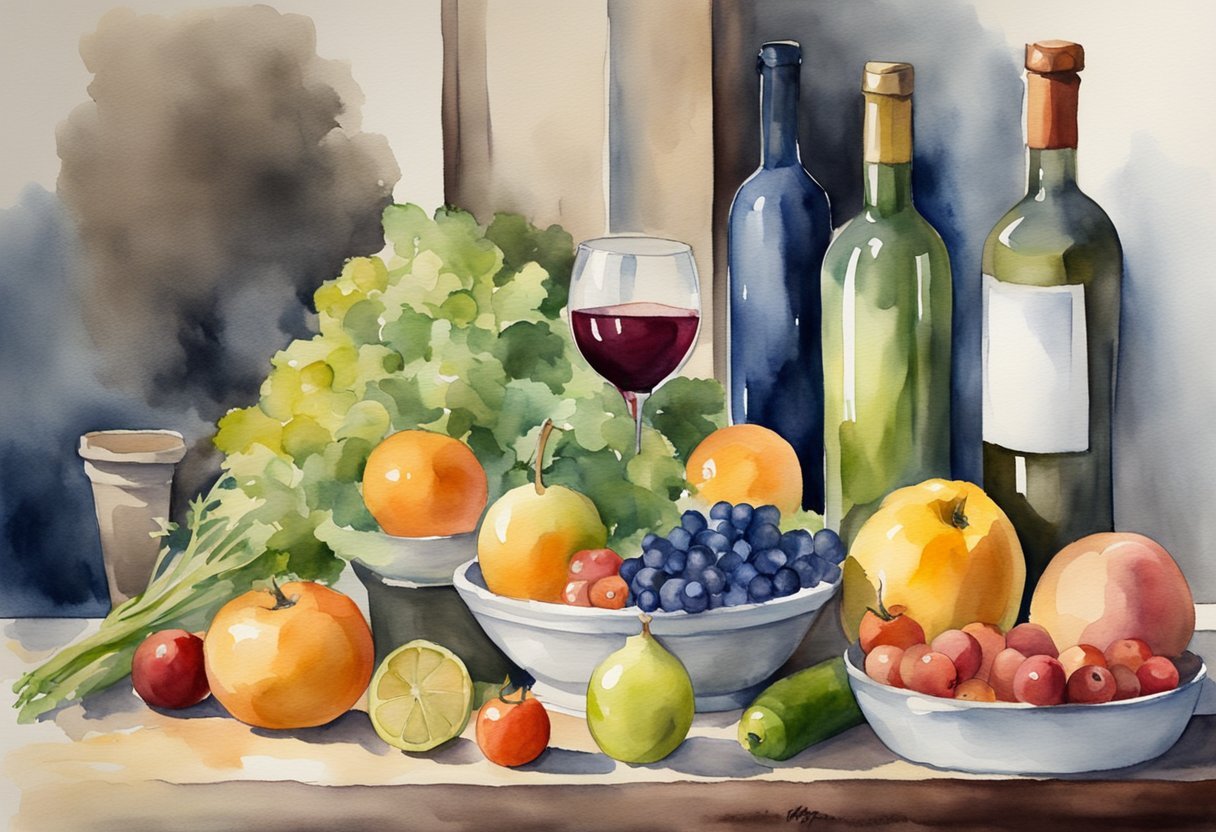
When choosing wines for weight loss, understanding their broader effects is essential.
While low-calorie options are great, consider your overall health and lifestyle too.
Holistic Approach to Weight Loss
Weight loss isn’t just about calories; it’s about your whole lifestyle.
Wine can fit into a balanced diet, but moderation is key since alcohol has calories and can increase your appetite.
Integrate exercise and nutritious foods to support your goals.
Pay attention to these aspects:
- Physical activity: Regular workouts help manage weight.
- Nutrition: Include fruits, veggies, lean proteins, and whole grains.
- Sleep: Good rest boosts metabolism.
- Staying hydrated: Drink water to help control hunger.
Alcohol’s Long-Term Effects
Alcohol affects more than your waistline.
Drinking wine can impact your liver, lead to high blood pressure, and increase risks of stroke and obesity.
Excessive drinking is linked to the growth of cancer cells.
So, it’s important to enjoy wine responsibly and not let it undermine your health goals.
Moderate your intake to protect your health in the long run.
- Liver: Drinking too much harms this vital organ.
- Blood pressure: Alcohol can raise it.
- Stroke: Higher risk with heavy drinking.
- Obesity: Empty calories from alcohol can lead to weight gain.
- Cancer: Some types of cancer have been linked to alcohol consumption.
Being mindful of these factors helps ensure that your weight loss efforts are healthy and sustainable.
Alternatives to Wine for Weight Loss

Finding alternatives to wine can be key if you’re looking to manage your weight more effectively.
Here are some non-alcoholic choices and healthy mocktail recipes to consider.
Non-Alcoholic Choices
When you’re trying to cut calories, alcoholic beverages can be tricky.
Luckily, there are several non-alcoholic choices that are both tasty and low in calories.
Sparkling water is a great option.
It gives you the fizzy satisfaction of champagne without the added sugars and calories.
You can also try herbal teas.
They come in various flavors and can be served hot or cold.
Some popular options include peppermint tea, chamomile tea, and green tea.
If you want something fruity, consider infused water.
Adding slices of cucumber, strawberry, or lemon to water gives it a flavorful twist without any extra calories or sugars.
Healthy Mocktail Recipes
Creating healthy mocktails can be a fun and delicious way to enjoy a drink while managing your weight.
One easy recipe is the Cucumber Mint Cooler.
Mix fresh cucumber slices with mint leaves in sparkling water.
Add a splash of lime juice for an extra zing.
Another great choice is the Berry Fizz.
Combine mixed berries with a bit of carbonated water and a squeeze of lemon juice.
It’s refreshing and keeps the calorie count low.
For a tropical option, make a Virgin Piña Colada.
Blend together coconut milk with pineapple juice and ice.
It’s creamy and satisfying but comes without the hangover risk.
These alternatives are not only flavorful but also help you stay on track with your health goals.
Frequently Asked Questions

When you’re trying to lose weight, choosing the right wine can make a difference.
Here’s what you need to know about picking wines that are lower in calories and carbs.
Which red wine can help in shedding pounds?
Pinot Noir is a great choice.
It’s lower in calories and rich in resveratrol, an antioxidant that may boost your metabolism.
Other good options include Merlot and Cabernet Sauvignon.
When’s the best time to sip some vino if you’re watching your weight?
Enjoy wine with or just after your meal.
Drinking wine on an empty stomach can lead to faster absorption and higher calorie intake.
Pairing it with food can help you manage your calorie consumption better.
Got any tips for drinking red wine but still slimming down?
Keep your servings small.
A typical serving size is 5 ounces.
Opt for dry wines rather than sweet ones since they usually have fewer calories.
Stay hydrated by sipping water between glasses.
Which is the skinny choice: red or white wine?
White wines like Sauvignon Blanc or Pinot Grigio are typically lower in calories.
However, red wines with high amounts of resveratrol can offer some metabolic benefits.
Both can fit into a weight-loss plan if consumed in moderation.
What’s the least calorie-packed wine to enjoy on a diet?
Light white wines like Chardonnay and Sauvignon Blanc are usually around 85-120 calories per serving.
Dry sparkling wines are also low in calories.
For reds, look for Pinot Noir or Merlot.
Is it possible to enjoy wine and still stay on track with weight loss?
Yes, you can enjoy wine in moderation.
Stick to 1-2 glasses per occasion and avoid sugary mixers.
Balance your wine intake with a healthy diet and regular exercise to stay on track with your weight-loss goals.






